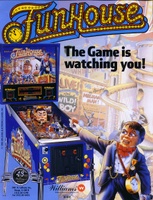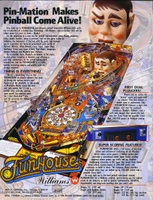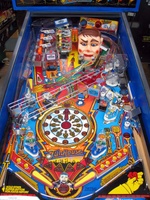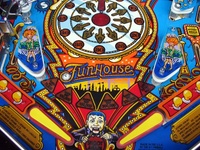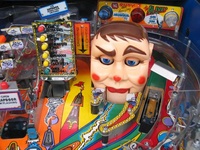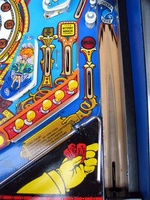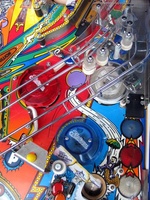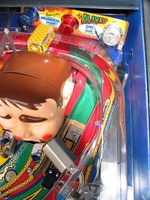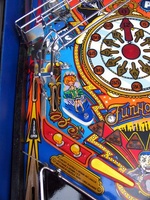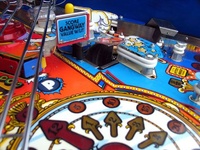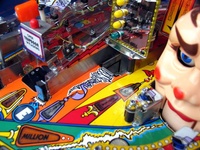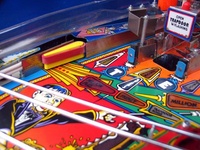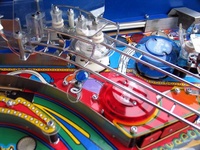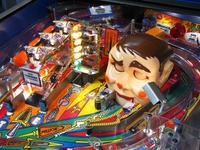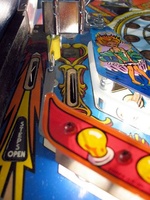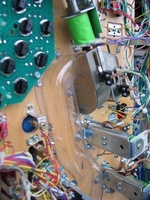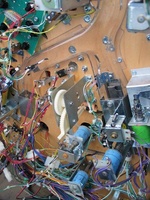
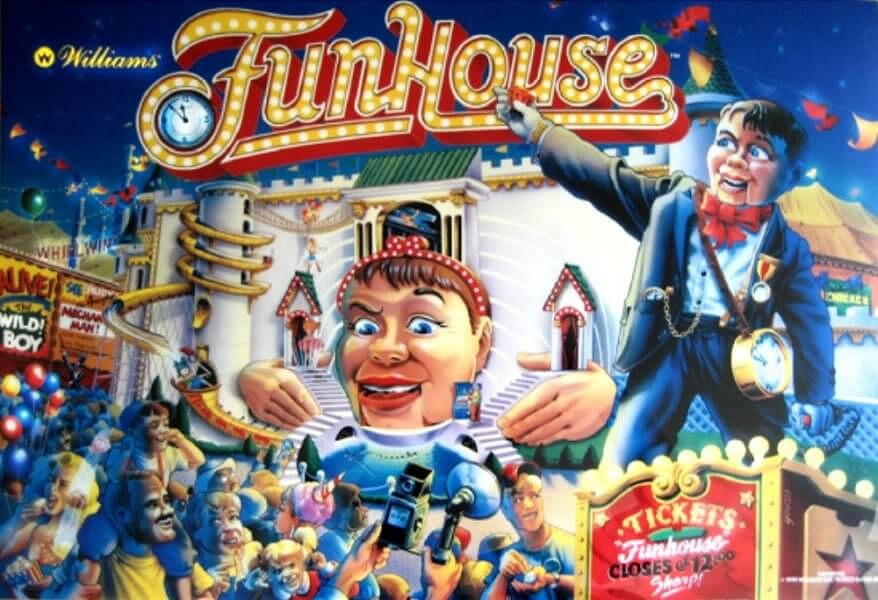
Funhouse
Ed Boon is the voice of Rudy. Pat Lawlor informs us that all Funhouse games left Williams with translites. No screened glass. According to Brian Eddy, he did not do work on the sound for this game as is sometimes stated. He stated at Expo 2004 that he did only display effects and some flasher effects for this game. Reportedly, about 200 of the first playfields made were manufactured with "Diamond Plate" covering. Additionally, several years later and due to dwindling replacement stock, a set of NOS replacement playfields was manufactured which also had the Diamond Plate covering, although these are also reported to suffer from having the red color 'bleed' around the center playfield clock. Also, early production models of Funhouse have the Williams System 11 sound board (part no. D-11581) hooked up to the WPC board (via an adapter), because the WPC sound board wasn't yet ready for distribution. Larry DeMar shares with us some of the design efforts:There was a mechanical clock created for Fun House. However it was a very different design than the clock which was used in Twilight Zone. Cost was one of the issues that led to the removal of the mechanical clock but the initial design which used two solenoid-operated stepper wheels rather than an electric motor was not reliable and Pat was uncomfortable with getting it fixed in the time frame we had to finish the game. So John Krutsch started work on the later design which was finally used in Twilight Zone. Rudy "names" each player and addresses that player by their name. Most interesting in a multi-player game but in my opinion a feature that we put a lot of effort into which had very little impact on the quality of the game (most people just didn't notice). The concept of [naming one of the players] "Slick" was that Rudy didn't like you and was picking on you, which we thought would cause buddies to rib each other in multi-player games but no one noticed this either besides discovering certain "rare" phrases like "zooooooooooooooooooooom"!Matt Walsh comments further:Light inserts on the lower playfield take the place of the clock's functionality. Each player who starts a game of Funhouse is given a name...like Chucky, Spunky, Bucko, and Slick. That name sticks for your player for each ball. It's not that obvious; I'm sure many people don't even notice that. Originally, the idea was that each of those names was to have it's own 'personality' such that Rudy would use varying phrases for each person. But all that remains of this feature is that some of Rudy's phrases will have the player's name inserted in. Well almost. If the player receives the name "Slick" - which is only possible in a two or more player game - the semi-derisive phrases will be used.In this listing are two close-up images of the Diamond Plate logo. One shows a playfield part number of 31-1605-SP while the other one shows 31-1607. Pat Lawlor explains why this is so:Funhouse playfields have a wide variety of part #'s and designations on them, both depending on when they were made in the run, and the vendor making them. VERY early prototype playfields have NO part # on them at all and do not say Diamond Plate. There ARE playfields that say " Protected by LS topcoat" since Lenc Smith did not use the Diamond Plate name. Williams had a problem with all of their vendors and keeping them straight. 31-1605-SP is an early Sun process playfield. 31-1607 is a later MULTI-vendor designation. Later, the only way to tell who made the playfield was to look at the edge of the playfield wood and check the marker designations. Adding to this confusion is that playfields could have been stored and then used early or later in the run, AND part sales playfields could have been done at almost any time in the run. What does this mean? Williams was worried that they needed to track the different vendors playfields in case of early wear out problems. So the odd part numbers were a way to try and track the vendors. It is simply a reflection of how many vendors were needed to keep the assembly line running on a daily basis. The manufacturer's flyer shows a playfield with five targets spelling S-T-E-P-S instead of the production games that have only four targets spelling S-T-E-P. In fact, in the flyer, the "P" standup target is missing and all one sees in its place is the small square hole in the playfield where the target should be. In addition, the makeup on Rudy's face is different. The five triangular bonus inserts near the flippers each do not have the words "Gang Way" on them. A fuller comparison of a prototype version to the production version can be found here. Williams used this game theme once before on Williams' 1956 'Fun House' which had three trap doors. A game with two talking heads is Williams' 1994 'Red & Ted's Road Show'. Production Run Records for Funhouse: Production Start Date: Nov-8-1990 Production End Date: Apr-10-1991 Production Run Quantity: approximately 10751, shipped quantities logged at 10781 without notation when records ended. First ship date: Nob-8-1990 Last ship date: unknown, missing records.
